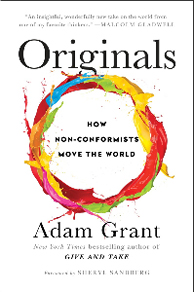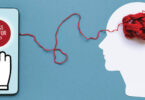The author of Give and Take returns with a case-filled instruction manual on how anyone can tap into originality.
Reviewed by Allan Fallow
We make a fundamental mistake when we sit in awe of those highly original types “who fuel creativity and drive change in the world,” writes Adam Grant in his latest collection of business wisdom. Assuming that great creators are cut from a different cloth than our own, he writes in Originals, is not just overly reverential, it’s debilitating: It keeps us from seeing that the creativity we too willingly impute to mavericks is well within our grasp as well.
To illustrate his point, he asks us right off to consider entrepreneurs: They’re real shoot-from-the-hip types, right? Freewheeling gamblers? Not so fast there, Bub: In a study made public in 2014, management researchers Joseph Raffiee and Jie Feng showed that entrepreneurs who hung on to their day jobs for as long as they could ran a 33 percent lower risk of experiencing business failure than those who threw caution to the winds. Future Nike CEO Phil Knight, for example, continued working as an accountant five years after he sold the first pair of running shoes from the trunk of his car. Internet search pioneers Larry Page and Sergey Brin were so fretful about dropping out of Stanford’s graduate school that they came close to never launching Google.
Take Action
Many of us are overflowing with ideas for how to improve our community, our children’s school or our workplace. Many of us have looked beyond the default systems that saddle us to question whether a better alternative might not be in the offing. Indeed, Grant believes the only thing that separates the bulk of us from demonstrated originals is that we have not yet seized the initiative—we have not yet taken the actions—required to make our visions a reality.
Kicking himself for “the worst financial decision I ever made”—in 2009, the author declined a pitch from its founders to invest in fledgling Warby Parker—Grant sets out to parse the success recipe that would earn the online eyewear enterprise the “most innovative company” award from Fast Company magazine just six years later, with annual revenues of $100 million and a valuation north of $1 billion. It wasn’t enough for the young guns behind Warby Parker to uncover the fact that traditional eyeglasses were so hideously expensive only because a single company—the European conglomerate Luxottica—had managed to get a chokehold on the market. To qualify as originals in Grant’s eyes, the company had to “reject the default and explore whether a better option exists.” And boy, did it: Warby Parker made eyeglasses easily accessible—and, at $95 per pair, affordable—for the first time online, smashing Luxottica’s monopoly in the market.
Aiming to take readers on a guided tour of applied originality, Grant does not merely report what social scientists are discovering about creativity. Instead, he suggests how we can fold their findings into our own lives. Want to maximize your chances of producing a masterpiece? Simply generate a higher number of notions, writes Grant in his chapter on the art and science of recognizing original ideas: “Creative geniuses weren’t qualitatively [emphasis added] better in their fields than their peers.” Grant says, crediting the work of psychologist Dean Simonton. “They simply produced a greater volume of work, which gave them more variation and a higher chance of originality.” Quantity, Grant concludes, is the surest path to quality.
Or perhaps you’ve hit on a novel idea and want to field-test how sound it might be. The most reliable feedback here is likely to come from a colleague, Grant says, not from a manager and certainly not from yourself—even geniuses are notoriously maladept at understanding when they have a hit on their hands. Sure, there’s no shinier badge of professional honor for a comedian than to make a fellow comic laugh, and magicians live for the moment when an original trick baffles a fellow prestidigitator. But the real reason that peer evaluations constitute the most reliable judgment of an idea’s originality is that our co-equals “lack the risk-aversion of managers and test audiences; they’re open to seeing the potential in unusual possibilities, which guards against false negatives. At the same time, they have no particular investment in our ideas, which gives them enough distance to offer an honest appraisal and protects against false positives.”
Within Your Reach
In a helpful appendix titled “Actions for Impact,” Grant suggests some concrete (but often quite simple) steps that any of us can take to push our simmering originality to a boil. One of them—to learn a new craft or immerse yourself in a new domain—was uncovered by a group of psychologists who studied what separates Nobel Prize-winning scientists from their everyday colleagues: It was simply that the standouts were more likely to have gotten involved in the arts at some point in their careers. The implications for all of us aspiring inventors and entrepreneurs are obvious, Grant writes: Those who contribute to patent applications or launch successful businesses “were more likely than their peers to have leisure-time activities that involved drawing, painting, architecture, sculpture, and literature.”
So, the takeaway? Originality is much more within our reach than we might imagine, and far less difficult than we might expect. Individuals can learn to voice and champion new ideas in the workplace, and—as a practical productivity tool—managers can learn to build cultures that welcome dissent. At home and in schools, parents can teach children how to feel comfortable questioning the “default systems” that too often block their view of a more just and creative world.
Oh, and you needn’t be a Kramer to make it happen. For the bulk of us, runs the reassuring message of Originals, the George Costanza approach should work just fine: “The most successful originals are not the daredevils who leap before they look,” says Grant, counterintuitively correcting the conventional wisdom. “They are the ones who reluctantly tiptoe to the edge of a cliff, calculate the rate of descent, triple-check their parachutes, and set up a safety net at the bottom just in case.”
You Might Also Like…
[Da Capo Press]
288 pages/$17.43/hardcover
A look at how advanced technology is changing the game of basketball—a perfect combination of science and sport.
[Portfolio]
224 pages/$14.01/hardcover
A great financial plan has nothing to do with what the markets are doing—it has everything to do with what’s most important to you.
[Hachette Books]
272 pages/$13.50/hardcover
Now a writer for HBO’s Silicon Valley, Dan Lyons shares his experience in the start-up world after working in the magazine industry for 25 years.
[W.W. Norton & Company]
368 pages/$15.70/hardcover
The new addition to the best-selling Naked series demystifies the world’s banking and monetary systems.









